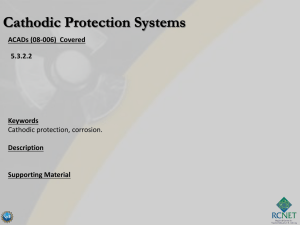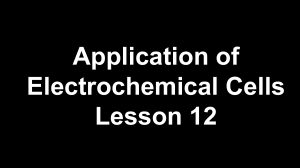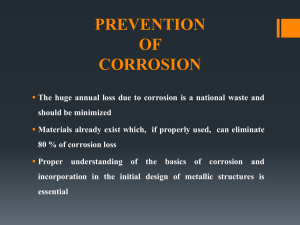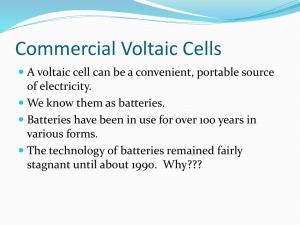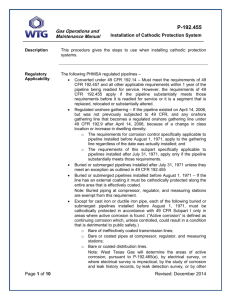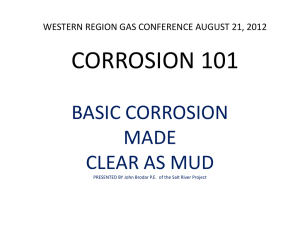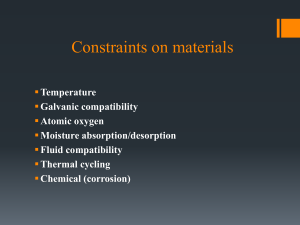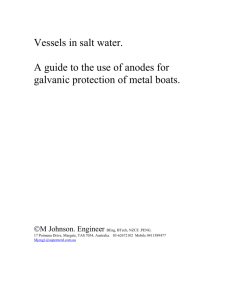corrosive) Environment
advertisement
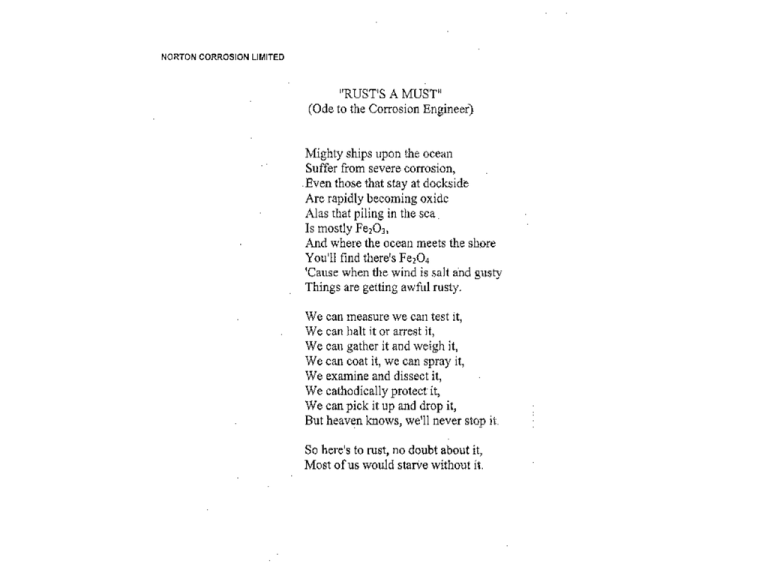
FUNDAMENTALS OF CORROSION CONTROL & CATHODIC PROTECTION 2 Outline Fundamentals of Corrosion Corrosion Cell: Conditions required for corrosion Corrosion Rate Corrosion Types Commonly Affected Structures Corrosion Control Materials Selection Inhibitors/Altering the environment Coatings Cathodic Protection Measuring potentials Criteria 3 Concerns Structural failure Contamination Property damage Costs to repair/replace Safety 4 5 6 7 8 9 Introduction to Corrosion Corrosion can be defined as the deterioration of metal due to its interaction with the environment. Corrosion is a natural phenomenon, which should not surprise one, but rather should be expected to occur. Metals are high energy materials, which exist because heat energy was added to natural iron ores during the smelting process. Nature, by environmental contact, constantly attacks these high energy materials and breaks them down to the natural elements from which they were derived. 10 Conditions Required for Corrosion Corrosion is an electrochemical process occurring at the interface between metal and environment. Three conditions must be present for this to occur. 1. Two areas on a structure or two structures must differ in electrical potential. 2. Those areas, called anodes and cathodes, must be electrically interconnected. 3. Those areas must be exposed to a common electrolyte (soil or water). 11 Two areas or two structures that differ in electrical potential (different amounts of stored energy) 12 The two areas, called the “Anode” and “Cathode”, must be electrically connected (conductive path) 13 Those areas must be exposed to a common electrolyte CURRENT FLOW WIRE CATHODE (COPPER) ANODE (IRON) CURRENTFLOW IONIZEDELECTROLYTE CURRENTFLOW (- TO+INELECTROLYTE) 14 Corrosion Cell – Dissimilar Metals i.e. steel pipe connected to copper ground rod CURRENT FLOW WIRE CATHODE (COPPER) ANODE (IRON) CURRENTFLOW IONIZEDELECTROLYTE CURRENTFLOW (- TO+INELECTROLYTE) 15 16 Corrosion Cell – Within a Metal 17 Corrosion Rate As a result of this process, electric current flows through the interconnection between cathode and anode. The cathodic area is protected from corrosion damage at the expense of the metal, which is consumed at the anode. The amount of metal lost is directly proportional to the current flow. Mild steel is lost at approximately 20 pounds for each ampere flowing for a year. 18 Factors Affecting Corrosion Rate Potential Difference Between Anode and Cathode (Galvanic Series) Circuit resistance – Resistivity of the Electrolyte Chemical Activity Stray Currents 19 Potential Difference Interconnecting two dissimilar metals in an electrolyte will create a corrosion cell. The strength of this cell increases as the distance within the galvanic series increases. 20 Galvanic Series Example: connecting magnesium to copper will produce a corrosion cell with a potential of about 1.5 volts. METAL VOLTS (CSE) Commercially Pure Magnesium -1.75 Magnesium Alloy -1.60 Zinc -1.10 Aluminum Alloy -1.05 Commercially Pure Aluminum -0.80 Mild Steel (clean & shiny) -0.50 to -0.80 Mild Steel (rusted) -0.20 to -0.50 Cast Iron (not graphitized) -0.50 Lead -0.50 Mild Steel in Concrete -0.20 Copper, Brass, Bronze -0.20 High Silicon Cast Iron -0.20 Carbon, Graphite, Coke +0.30 21 Circuit Resistance Circuit resistance includes the following: Resistance of the anode Resistance of the cathode Resistance of the electrolyte Resistance of the metallic path Increasing the resistance will reduce the corrosion rate. 22 Resistance of Common Electrolytes Soils – High resistivity water reduces the corrosion rate, while low resistivity water increases the corrosion rate. CLASSIFICATION ELECTROLYTE RESISTIVITY (ohm-cm) ANTICIPATED CORROSIVITY Low Resistance 0 to 2,000 Severe Medium 2,000 to 10,000 Moderate High 10,000 to 30,000 Mild Very High Above 30,000 Increasingly Less 23 Resistance of Common Electrolytes Water – Approximate resistivity values Water resistivity open sea seawater (coastal) river water tap water rain water distilled water pure water Ohms-cm 20-25 30-40 500-10,000 1,000-10,000 20,000 500,000 20,000,000 24 Chemical Activity Passive (less corrosive) Environment High pH (neutral or basic) Low Moisture Content Lack of Salts High Resistivity Low Temperature Homogenous Environment 25 Chemical Activity Active (more corrosive) Environment Low pH (acidic) High Moisture Content Salts Low Resistivity Moderate to High Temperature Heterogeneous Environment 26 Stray current corrosion 1 2 3 Boat Boat Boat Ground wire Corrosion Type Uniform or near uniform - Corrosion attacks all areas of the metal at the same or similar rate. Localized - Some areas of the metal corrode at different rates due to heterogeneities in the metal or environment. This type of attack can approach pitting. Pitting - Very highly localized attack resulting in small pits that may penetrate to perforation. 28 29 Commonly Affected Structures Buried Piping Steel Piles Storage Tanks - Above Ground / Underground Reinforcing Steel in Concrete Ships/Boats 30 31 32 33 34 Ships/Boats 35 36 37 38 Methods to Control Corrosion Use of Corrosion resistant materials (plastic, stainless alloys, fiberglass). Use of the same or similar metals per the galvanic series. Altering the environment (utilizing homogeneous high resistivity backfill or inhibitors). Utilize coatings and linings that electrically insulate the structure from the electrolyte (paints, plastic films, etc). Use of Cathodic Protection. 39 Fundamentals of Cathodic Protection Cathodic Protection (CP) Defined - Minimize corrosion by utilizing an external source of electrical current which forces the entire structure to become a cathode. 40 1824: Earliest practical use of cathodic protection Sir Humphrey Davy’s work on protecting the copper sheathing on wooden hulls in the British Navy by sacrificial zinc or iron anodes is generally considered to be the earliest example of practical cathodic protection. 41 42 43 Galvanic CP When metals such as magnesium or zinc are placed in the environment in contact with a more noble metal such as steel, a current flows from the more active anode to the noble cathode (corrosion cell). 44 Anodes Used for Galvanic CP Magnesium – Magnesium is often used in soil to protect small electrically isolated structures, such as underground storage tanks, and well coated pipelines. Zinc – Zinc is often used in marine environments. They are commonly found on boats. Aluminum – Aluminum can be used for a variety of marine applications. 45 46 47 48 Keys to obtaining enough cathodic protection Determine amount of current required Theoretical calculations based on coating quality and environment Or, perform current requirement testing Calculate output expected from anode and determine number of anodes required. 49 Galvanic CP Pros of Galvanic CP Inexpensive Little Maintenance cost No external Power source A variety of install methods can be used. For example, many UST’s are shipped with anodes attached. 50 Galvanic CP Cons of Galvanic CP Typically work best with electrically isolated structures. No external power source, limited driving potential (driving potential based on the galvanic series) Limited output makes it ineffective when trying to protect large uncoated surfaces. Require a low resistivity electrolyte to function well. 51 52 53 54 55 56 57 58 59 Impressed Current CP Utilize an external power source to develop a high potential difference between the surface to be protected and an anode. 60 Impressed Current CP IM P R E S S E D An o d e C U R G ro u n d b e d P o s i ti v e C a b l R e c ti fi e r AC P o w e N r S u a p t pi v l ye e g P ip e lin e C a b Impressed Current CP Pros of Impressed Current CP Unlimited driving potential. Capable of protecting large steel structures when designed properly. Requires less anodes then a galvanic system. Output can be controlled using a permanent reference electrode, desirable when the electrolyte resistivity is known to change. 62 Impressed Current CP Cons of Impressed Current CP Initial costs can be more expensive. Requires an external DC power source along with an AC supply. System requires routine maintenance and monitoring. Anode wires can be susceptible to damage. 63 Impressed Current CP Rectifier A rectifier converts available AC power to low voltage DC power. Most cathodic protection rectifiers are provided with a means to vary the DC output voltage in small increments, or in some cases offer complete control from zero to 100% of rated DC output. 64 65 66 CP System Testing A CP system can be evaluated by obtaining a reference cell potential. This potential determines the amount of cathodic polarization the structure is receiving. Adequate protection is indicated by obtaining a value more negative then the established criteria. This criteria is specific to the reference cell used to obtain potentials. 67 68 Questions? 69

